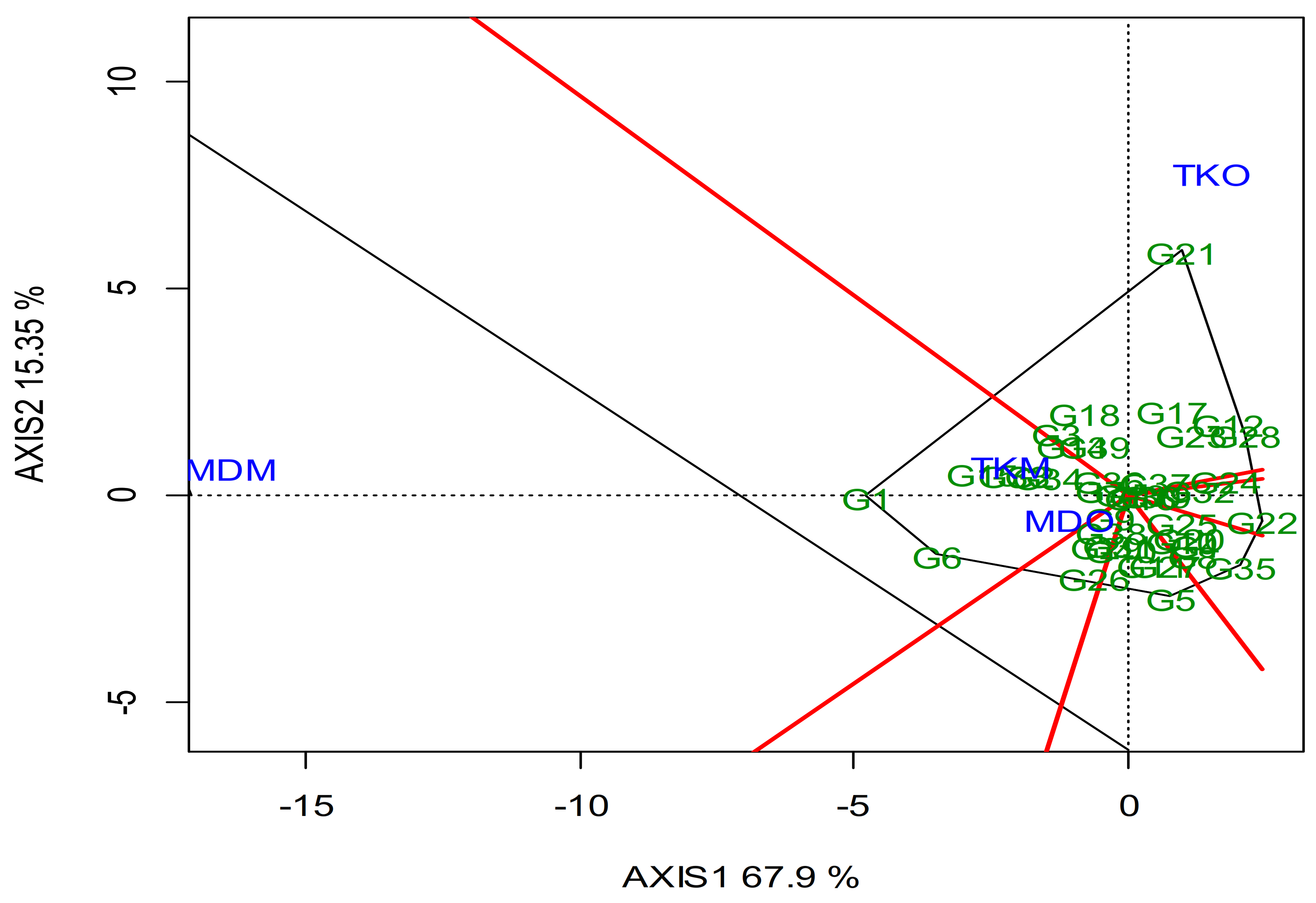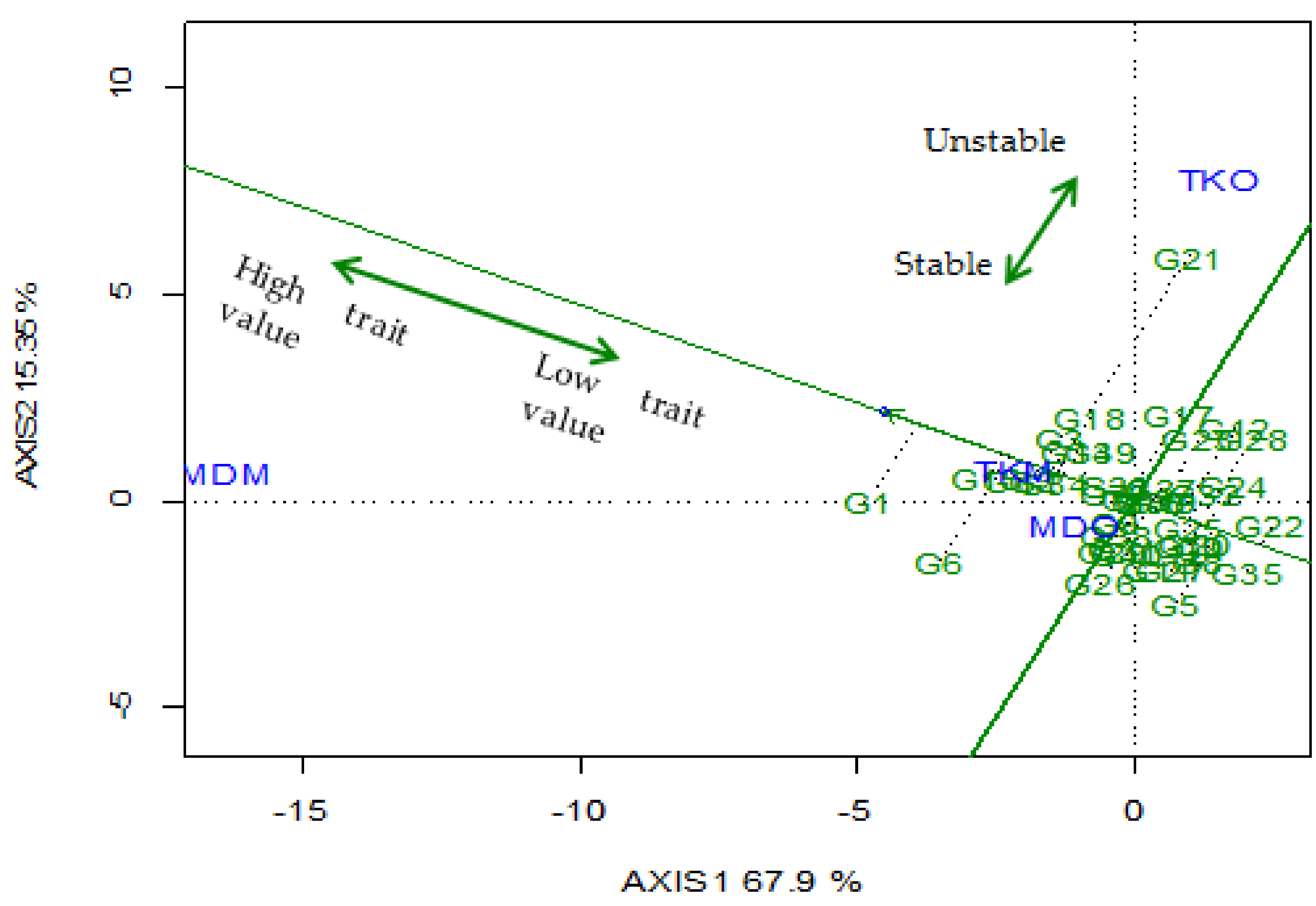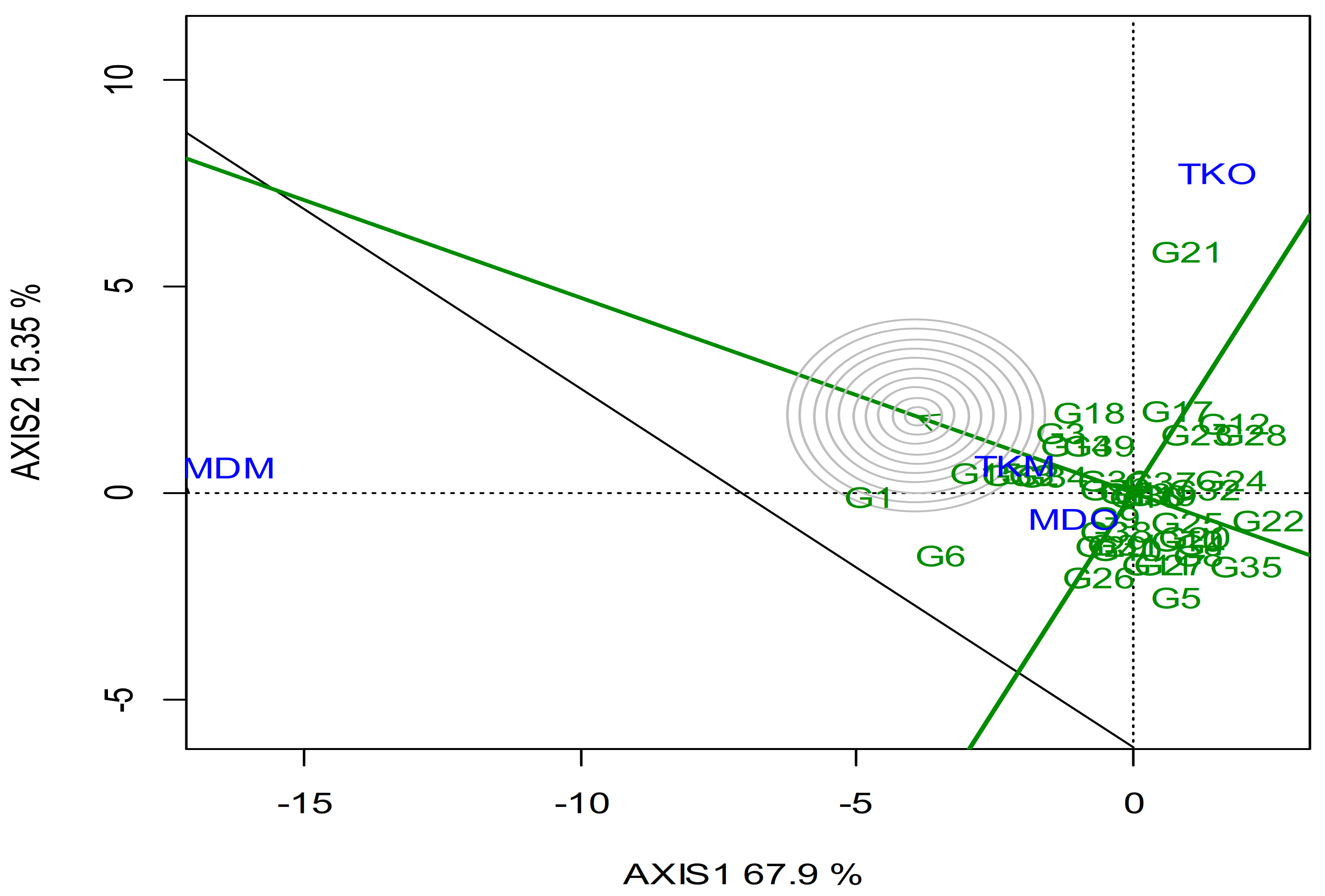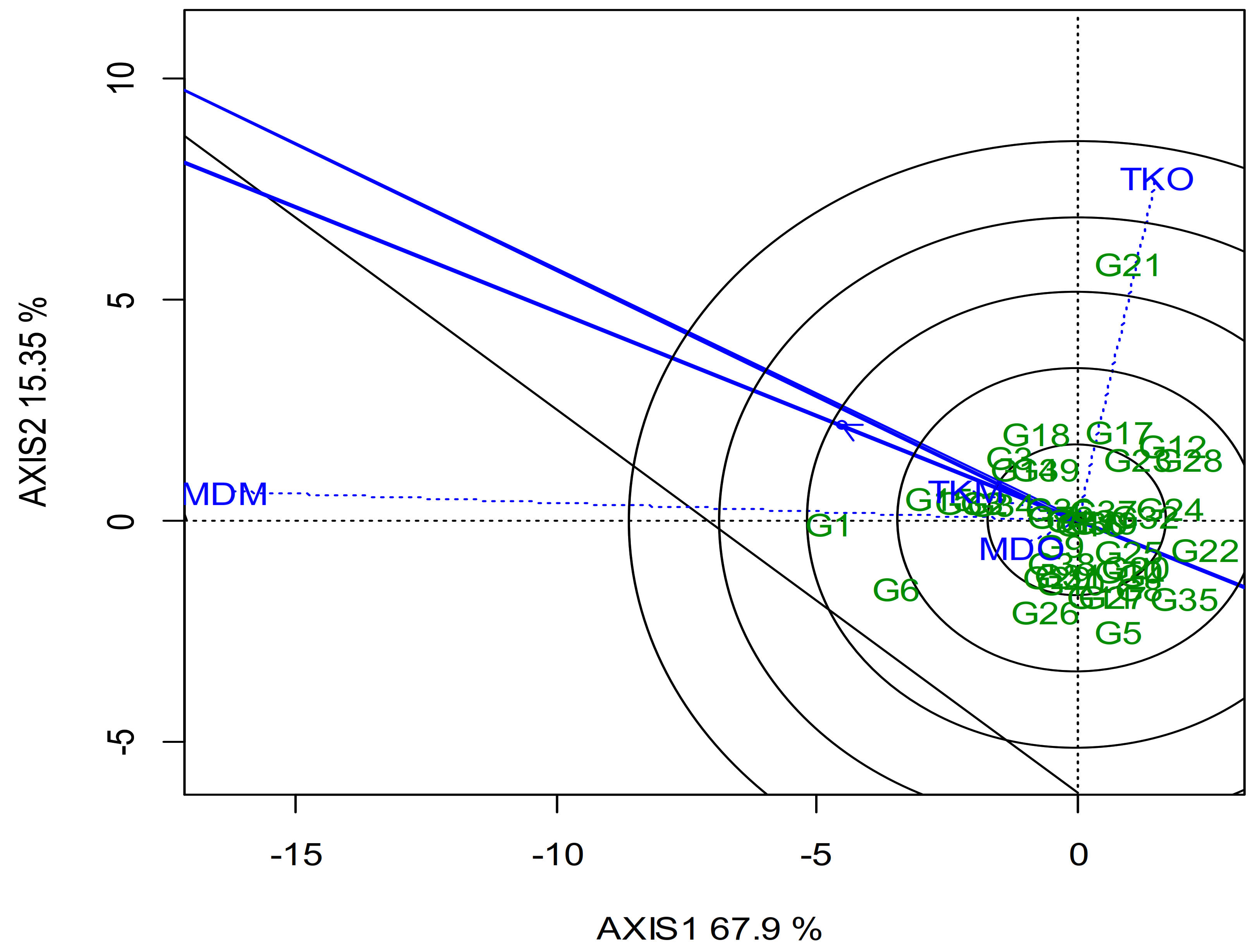Integrating Multivariate and Univariate Statistical Models to Investigate Genotype–Environment Interaction of Advanced Fragrant Rice Genotypes under Rainfed Condition
Abstract
:1. Introduction
2. Materials and Methods
2.1. Planting Material, Environments, and Cultural Practices
2.2. Statistical Analysis
3. Results
3.1. Combined Analysis of Variance for Grain Yield
3.2. Multivariate Analysis as Explain by GGE Biplot Graph
3.2.1. Which-Won-Where vs. Mega Environment View GGE Biplot Graph
3.2.2. Mean Versus Stability Views of GGE Biplot and Ideal Genotype Comparison
3.2.3. Discriminative vs. Representative View of GGE Biplot (Relationship among Test Environments)
3.3. Genotype Means Comparison
3.4. Univariate Stability Methods
3.5. Rank Correlations among the Univariate Stability Models
4. Conclusions
Author Contributions
Funding
Institutional Review Board Statement
Informed Consent Statement
Data Availability Statement
Conflicts of Interest
References
- Oladosu, Y.; Rafii, M.Y.; Abdullah, N.; Abdul Malek, M.; Rahim, H.A.; Hussin, G.; Kareem, I. Genetic variability and selection criteria in rice mutant lines as revealed by quantitative traits. Sci. World J. 2014. [Google Scholar] [CrossRef] [PubMed] [Green Version]
- Asma, I.K.; Rafii, M.Y.; Sobri, H.; Anna, L.P.K.; Rahim, A.H.; Mahmud, T.M.M.; Oladosu, Y. Physicochemical characteristics and nutritional compositions of MR219 mutant rice and their effects on glycaemic responses in BALB/c mice. Int. Food Res. J. 2019, 126, 1477–1484. [Google Scholar]
- Oladosu, Y.; Rafii, M.Y.; Samuel, C.; Fatai, A.; Magaji, U.; Kareem, I.; Kolapo, K. Drought resistance in rice from conventional to molecular breeding: A review. Int. J. Mol. Sci. 2019, 20, 3519. [Google Scholar] [CrossRef] [PubMed] [Green Version]
- Oladosu, Y.; Rafii, M.Y.; Arolu, F.; Chukwu, S.C.; Muhammad, I.; Kareem, I.; Arolu, I.W. Submergence tolerance in rice: Review of mechanism, breeding and future prospects. Sustainability 2020, 12, 1632. [Google Scholar] [CrossRef] [Green Version]
- Giraud, G. The world market of fragrant rice, main issues and perspectives. Int. Food Agribus. Manag. Rev. 2013, 16, 1–20. [Google Scholar]
- Singh, R.K.; Gautam, P.L.; Saxena, S.; Singh, S. Scented Rice Germplasm: Conservation, Evaluation and Utilization. In Aromatic Rices; Singh, R.K., Singh, U.S., Khush, G.S., Eds.; Oxford & IBH: Kalyani, New Delhi, 2000; pp. 107–133. [Google Scholar]
- Lau, W.C.P.; Rafii, M.Y.; Ismail, M.R.; Puteh, A.; Latif, M.A.; Asfaliza, R.; Miah, G. Development of advanced fragrant rice lines from MR269× Basmati 370 through marker-assisted backcrossing. Euphytica 2017, 213, 1–15. [Google Scholar] [CrossRef]
- Oladosu, Y.; Rafii, M.Y.; Abdullah, N.; Magaji, U.; Miah, G.; Hussin, G.; Ramli, A. Genotype× Environment interaction and stability analyses of yield and yield components of established and mutant rice genotypes tested in multiple locations in Malaysia. Acta Agric. Scand B Soil Plant Sci. 2017, 67, 590–606. [Google Scholar] [CrossRef]
- Sabri, R.S.; Rafii, M.Y.; Ismail, M.R.; Yusuff, O.; Chukwu, S.C.; Hasan, N.A. Assessment of agro-morphologic performance, genetic parameters and clustering pattern of newly developed blast resistant rice lines tested in four environments. Agronomy 2020, 10, 1098. [Google Scholar] [CrossRef]
- Oladosu, Y.; Rafii, M.Y.; Magaji, U.; Abdullah, N.; Miah, G.; Chukwu, S.C.; Kareem, I. Genotypic and phenotypic relationship among yield components in rice under tropical conditions. Biomed. Res. Int. 2018. [Google Scholar] [CrossRef] [Green Version]
- Myint, K.A.; Amiruddin, M.D.; Rafii, M.Y.; Abd Samad, M.Y.; Ramlee, S.I.; Yaakub, Z.; Oladosu, Y. Genetic diversity and selection criteria of MPOB-Senegal oil palm (Elaeis guineensis Jacq.) germplasm by quantitative traits. Ind. Crops Prod. 2019, 139, 111558. [Google Scholar] [CrossRef]
- Wade, L.J.; McLaren, C.G.; Quintana, L.; Harnpichitvitaya, D.; Rajatasereekul, S.; Sarawgi, A.K.; Sarkarung, S. Genotype by environment interactions across diverse rainfed lowland rice environments. Field Crops Res. 1999, 64, 35–50. [Google Scholar] [CrossRef]
- Yan, W.; Hunt, L.A.; Sheng, Q.; Szlavnics, Z. Cultivar evaluation and mega-environment investigation based on the GGE biplot. Crop. Sci. 2000, 40, 597–605. [Google Scholar] [CrossRef]
- Redona, D.E. Standard Evaluation System (SES) for Rice, 5th ed.; International Rice Research Institute: Los Baños, CA, USA, 2013. [Google Scholar]
- Dia, M.; Wehner, T.C.; Arellano, C. Analysis of Genotype X Environment Interaction (GxE) Using SAS Programming. 2015. Available online: http://cuke.hort.ncsu.edu/cucurbit/wehner/software.html (accessed on 17 February 2021).
- RStudio. RStudio: Integrated Development Environment for R (Computer Software v0.98.1074). 2014. Available online: http://www.rstudio.org/ (accessed on 17 February 2021).
- Yan, W.; Kang, M.S.; Ma, B.; Woods, S.; Cornelius, P.L. GGE biplot vs. AMMI analysis of genotype-by-environment data. Crop. Sci. 2007, 47, 643–653. [Google Scholar] [CrossRef]
- Dehghani, H.; Ebadi, A.; Yousefi, A. Biplot analysis of genotype by environment interaction for barley yield in Iran. Agron J. 2006, 98, 388–393. [Google Scholar] [CrossRef]
- Kang, M.S.; Pham, H.N. Simultaneous selection for high yielding and stable crop genotypes. Agron J. 1991, 83, 161–165. [Google Scholar] [CrossRef]
- Becker, H.C.; Leon, J. Stability analysis in plant breeding. Plant. Breed. 1988, 101, 1–23. [Google Scholar] [CrossRef]
- Oladosu, Y.; Rafii, M.Y.; Magaji, U.; Abdullah, N.; Ramli, A.; Hussin, G. Assessing the representative and discriminative ability of test environments for rice breeding in Malaysia using GGE Biplot. Int. J. Sci. Technol. Res. 2017, 6, 8–16. [Google Scholar]
- Haldane, J.B.S. The interaction of nature and nurture. Ann. Eugen. 1946, 13, 197–205. [Google Scholar] [CrossRef]
- Yan, W.; Kang, M.S. GGE Biplot Analysis: A Graphical Tool for Breeders, Geneticists, and Agronomists; CRC Press: New York, NY, USA, 2002; p. 71. [Google Scholar]
- Gauch, H.G.; Zobel, R.W. AMMI Analysis of Yield Trials. In Genotype by Environment Interaction; Kang, M.S., Gauch, H.G., Eds.; CRC Press: Boca Raton, FL, USA, 1996; pp. 85–122. [Google Scholar]
- Eberhart, S.T.; Russell, W.A. Stability parameters for comparing varieties 1. Crop. Sci. 1966, 6, 36–40. [Google Scholar] [CrossRef] [Green Version]
- Finlay, K.W.; Wilkinson, G.N. The analysis of adaptation in a plant-breeding programme. Aust. J. Agric. Res. 1963, 14, 742–754. [Google Scholar] [CrossRef] [Green Version]
- Shukla, G.K. Some statistical aspects of partitioning genotype environmental components of variability. Heredity 1972, 29, 237–245. [Google Scholar] [CrossRef]
- Wricke, G. Uber eine Methode zur Erfassung der okologischen Streubreite in Feldverzuchen. Z. Pflanzenzuchtg 1962, 47, 92–96. [Google Scholar]
- Kang, M.S. Simultaneous selection for yield and stability in crop performance trials: Consequences for growers. Agron. J. 1993, 85, 754–757. [Google Scholar] [CrossRef]
- Mekbib, F. Yield stability in common bean (Phaseolus vulgaris L.) genotypes. Euphytica 2003, 130, 147–153. [Google Scholar] [CrossRef]





| Location Code | Season | Coordinate | Soil Texture | Alt. | Av. Temp. | Av. Hum | Av. Rainfall (Monthly) |
|---|---|---|---|---|---|---|---|
| TKM | Main | 3°25′0″ N 101°10′ E | Silty clay loam | 3 m | 23 °C–31 °C | 83 | 792.6 (197.6) |
| MDO | off | 5°59′ N 100°24′ E | Clay loam | 18 m | 25 °C–38 °C | 63 | 487.7 (122.7) |
| MDM | Main | 5°59′ N 100°24′ E | Clay loam | 18 m | 22 °C–33 °C | 91 | 560.6 (138.2) |
| TKO | off | 3°25′0″ N 101°10′ E | Silty clay loam | 3 m | 25 °C–37 °C | 65 | 489.5 (120.7) |
| Source | DF | Mean Square | % of GE |
|---|---|---|---|
| Rep (location) | 4 | 18.86 ** | 2.00 |
| Location (L) | 1 | 578.69 ** | 37.01 |
| Season (S) | 1 | 237.64 ** | 6.31 |
| Genotype (G) | 39 | 8.81 ** | 15.36 |
| G × S | 39 | 8.85 ** | 9.16 |
| G × L | 39 | 8.01 ** | 8.29 |
| G × L × S | 40 | 11.99 ** | 12.73 |
| Error | 316 | 4.41 | 9.12 |
| Gen | MEAN | bi | S2d | W2i | σi2 | YSi |
|---|---|---|---|---|---|---|
| G1 | 6.89 ± 1.58 a | 0.70 | 10.90 | 154.70 | 54.08 *** | 34 |
| G2 | 4.68 ± 0.53 b–j | 2.32 | 8.62 * | 42.36 | 14.67 * | 15 |
| G3 | 4.36 ± 0.61 c–k | 0.52 | 2.72 | 15.98 | 5.41 | 16 |
| G4 | 5.28 ± 0.92 a–i | 1.21 | 3.39 | 18.57 | 6.32 | 31 |
| G5 | 5.07 ± 0.83 b–j | −0.20 | 0.35 | 0.59 | 0.01 | 29 |
| G6 | 4.29 ± 0.71 d–k | 1.44 | 0.81 | 2.39 | 0.64 | 15 |
| G7 | 5.06 ± 0.77 b–j | 1.38 | 2.06 | 5.67 | 1.79 | 28 |
| G8 | 5.70 ± 0.79 a–f | 1.98 | 0.97 | 2.48 | 0.67 | 36 |
| G9 | 4.17 ± 0.72 e–k | 0.65 | 1.35 | 4.54 | 1.39 | 10 |
| G10 | 5.27 ± 0.97 a–i | 1.15 | 4.12 | 32.19 | 11.09 * | 26 |
| G11 | 5.44 ± 0.95 a–h | 0.01 | 3.88 | 17.14 | 5.82 | 32 |
| G12 | 3.39 ± 0.57 jk | 1.31 | 0.29 | 2.04 | 0.52 | 1 |
| G13 | 4.03 ± 0.60 f–k | 0.60 | 7.45 * | 21.25 | 7.26 | 8 |
| G14 | 5.88 ± 1.50 a–d | 2.28 | 8.86 | 103.02 | 35.95 *** | 30 |
| G15 | 5.02 ± 0.64 b–j | 0.06 | 1.92 | 3.05 | 0.87 | 27 |
| G16 | 4.27 ± 0.45 d–k | 0.93 | 4.19 | 20.95 | 7.15 | 14 |
| G17 | 5.47 ± 1.21 a–h | 2.80 | 11.67 | 34.33 | 11.85* | 29 |
| G18 | 3.73 ± 0.47 ijk | 1.38 | 0.33 | 2.07 | 0.53 | 3 |
| G19 | 4.18 ± 0.92 e–k | 0.22 | 2.30 | 4.27 | 1.30 | 11 |
| G20 | 4.91 ± 0.85 b–j | 1.66 | 9.52 | 17.70 | 6.01 | 26 |
| G21 | 5.48 ± 0.80 a–h | 0.42 | 3.82 | 9.78 | 3.23 | 34 |
| G22 | 6.03 ± 1.19 abc | 1.68 | 2.73 | 61.13 | 21.25 ** | 31 |
| G23 | 4.46 ± 0.62 c–j | −0.04 | 1.13 | 0.65 | 0.03 | 18 |
| G24 | 4.68 ± 0.53 b–j | 0.49 | 3.14 | 15.34 | 5.19 | 20 |
| G25 | 5.81 ± 0.90 a–e | 2.27 | 2.00 | 6.96 | 2.24 | 37 |
| G26 | 4.24 ± 0.73 d–k | 2.34 | 2.07 | 2.38 | 0.64 | 12 |
| G27 | 3.84 ± 0.50 h–k | 1.37 | 0.35 | 4.59 | 1.41 | 5 |
| G28 | 5.56 ± 1.23 a–g | 0.05 | 21.47 | 73.46 | 25.58 *** | 27 |
| G29 | 3.83 ± 0.53 h–k | −0.04 | 4.87 | 53.88 | 18.71 ** | −4 |
| G30 | 3.87 ± 0.41 h–k | 0.77 | 1.60 | 20.88 | 7.13 | 6 |
| G31 | 4.25 ± 0.45 d–k | −0.51 * | 2.44 | 9.94 | 3.29 | 13 |
| G32 | 4.89 ± 0.89 b–j | 2.18 | 5.41 | 17.14 | 5.82 | 25 |
| G33 | 3.91 ± 0.59 g–k | 1.57 | 0.77 | 2.42 | 0.65 | 7 |
| G34 | 3.73 ± 0.47 ijk | 0.81 | 3.48 | 36.60 | 12.64 * | −2 |
| G35 | 4.84 ± 0.77 b–j | 0.45 | 2.04 | 6.76 | 2.17 | 24 |
| G36 | 4.82 ± 0.51 b–j | 1.27 | 0.74 | 3.42 | 1.00 | 23 |
| G37 | 4.39 ± 0.70 c–j | 0.75 | 1.11 | 4.60 | 1.42 | 17 |
| G38 | 4.16 ± 0.47 e–k | 1.20 | 2.19 | 12.51 | 4.19 | 9 |
| G39 | 6.16 ± 0.92 ab | 0.41 | 1.48 | 20.03 | 6.83 | 40 |
| G40 | 2.70 ± 0.30 k | 0.18 | 0.37 | 7.67 | 2.49 | −1 |
| M | bi | S2d | W2i | σi2 | YSi | |
|---|---|---|---|---|---|---|
| M | 1 | |||||
| bi | 0 | 1 | ||||
| S2d | −0.40 ** | 0.04 | 1 | |||
| W2i | −0.33 * | 0.13 | 0.83 *** | 1 | ||
| σi2 | −0.33 * | 0.13 | 0.83 *** | 1.00 *** | 1 | |
| YSi | 0.98 *** | −0.03 | −0.29 | −0.19 | −0.19 | 1 |
Publisher’s Note: MDPI stays neutral with regard to jurisdictional claims in published maps and institutional affiliations. |
© 2021 by the authors. Licensee MDPI, Basel, Switzerland. This article is an open access article distributed under the terms and conditions of the Creative Commons Attribution (CC BY) license (https://creativecommons.org/licenses/by/4.0/).
Share and Cite
Hashim, N.; Rafii, M.Y.; Oladosu, Y.; Ismail, M.R.; Ramli, A.; Arolu, F.; Chukwu, S. Integrating Multivariate and Univariate Statistical Models to Investigate Genotype–Environment Interaction of Advanced Fragrant Rice Genotypes under Rainfed Condition. Sustainability 2021, 13, 4555. https://doi.org/10.3390/su13084555
Hashim N, Rafii MY, Oladosu Y, Ismail MR, Ramli A, Arolu F, Chukwu S. Integrating Multivariate and Univariate Statistical Models to Investigate Genotype–Environment Interaction of Advanced Fragrant Rice Genotypes under Rainfed Condition. Sustainability. 2021; 13(8):4555. https://doi.org/10.3390/su13084555
Chicago/Turabian StyleHashim, Norainy, Mohd Y. Rafii, Yusuff Oladosu, Mohd Razi Ismail, Asfaliza Ramli, Fatai Arolu, and Samuel Chukwu. 2021. "Integrating Multivariate and Univariate Statistical Models to Investigate Genotype–Environment Interaction of Advanced Fragrant Rice Genotypes under Rainfed Condition" Sustainability 13, no. 8: 4555. https://doi.org/10.3390/su13084555






